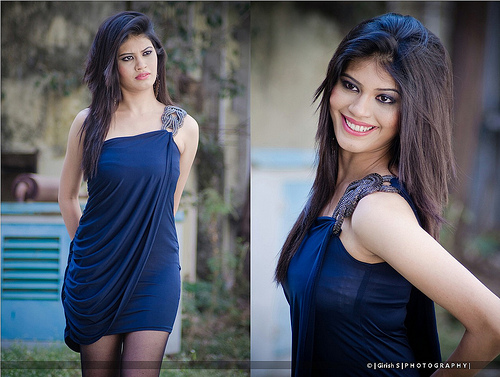In the world of photography beginners are almost always compelled to get everything in focus. This habit is usually based on the notion that photography is all about faithfully recording all of the elements in a frame; presenting them in sharp focus. However by using shallow depth of field photography can become far more interesting. By restricting the depth of field in a photograph the photographer can direct the attention of the viewer towards a specific object, person or area.

Notice how the image on the right has less depth of field than the one on the left. The woman is not as clearly separated from the background in the left hand image. Whereas with the right hand image the limited depth of field makes her stand out from the background and draws the viewer’s attention to her face and body – rather than any distractions beyond her.
Is it Art or Science?
Experienced photographers will remind the beginner that it is not always desirable to keep everything in a photograph pin-sharp. In many instances the ability to soften or totally blur areas of the frame, that is to employ shallow depth of field, photography becomes more like art. The subjectivity that shallow depth of field provides allows the photographer to interpret their scene rather than simply record it.
To utilize this aspect of photography a photographer needs to learn how to manipulate the camera so that the subject is sharp while the surrounding objects in front or behind the object exhibit a ‘soft’ image because of the lack of sharpness. The purpose for using this technique is to create a dramatic image that the eye can focus upon, and as a result, viewers could appreciate the central object and rather than the surrounding clutter.
Using Shallow Depth of Field Photography for Portraits
In addition, the use of this strategy helps eliminate the presence of a confusing background that could create distraction for viewers. The following image shows this well:

By choosing only a particular object to focus upon while everything melts in the background, the photographer simplifies his or her visual message and the viewers will more clearly understand what he or she is trying to convey to them. In order to achieve this effect, the photographer must remember two elements: f stop and depth of field.
Large Aperature = Small Depth of Field
A shallow depth of field is possible because of the principle that cameras focus on objects based on the distance from the camera and the subject.
In a low depth range, there are only a few parts of the scene that the camera could focus on. Conversely, a high depth enables the camera to focus on many parts of the scene, and therefore, most of the objects within the frame are also in sharp focus.
The use of the said order tramadol online technique enables the photographer to create a background with a soft blur while the subject is in sharp focus. The effect could be achieved by choosing a wide aperture, especially when the photographer is shooting in low light. In most cases the wide aperture necessary to create this effect ranges from f/5.6 to f/1.2. If the effect is required in bright lighting conditions then a neutral density filter is normally required to reduce the amount of light entering the camera lens.
The aperture values chosen are dependent on the kind of lens used by the photo enthusiast. It must be made clear that lenses are a factor when it comes to achieving a lower range. A telephoto lens provides a shallower depth compared than those that are found on ordinary cameras. A normal or wide-angle lens is usually installed in ordinary cameras.
Compact Cameras – a Problem?
It is interesting to note that due to the small size of the image sensor in many compact and pocket digital cameras, the lens are said to have a relatively short focal length. Since the lens of ordinary digital cameras could only provide a short focal length, the inadvertent result is the creation of images that have more depth of field. As a result novice photographers and regular photo enthusiasts almost always produce images where everything is in focus and the background is as sharp as the subject matter of a particular photo.

by Bengt Nyman
The limitations of a compact and pocket digital cameras means that photographers who could not afford to purchase highly advanced cameras are almost always denied the joy of creating a stunning photo composition where the beautiful subject matter stands out in the middle of the frame. However, there is a way to go around this particular technical limitation.
A Solution for (some) Compact Cameras
In order to achieve the desired effect using a small camera, the user must zoom to the longest telephoto focal length and when the photographer is sure that he or she has reached the maximum allowable focal length, he or she must select the widest possible f-stop setting.
The final step requires the photographer to step back and take the shot. The outcome is a more blurry background emulating the effect of a professional photographer with the ability to compose images with a shallow depth of field. Shallow depth of field examples could be viewed on many photography websites. It is time to explore. Learn more about photography from experts. However, a photo enthusiast can start at any level.
The challenges faced by novice photographers can be understood from the point of view of economics. Cameras are expensive. The realization that compact cameras are severely limited when it comes to the creation of stunning images increases the yearning for more advanced equipment. It is therefore necessary to find ways to acquire better equipment even on a budget.
